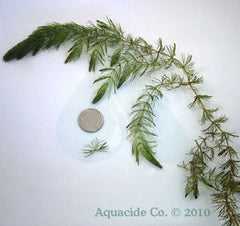COONTAIL

Coontail (Ceratophyllum demersum, also called Hornwort) are rootless, submersed, perennial lake weeds that often form dense colonies. Leaves are stiff, whorled with many forks and have small teeth along one edge of the fork. Coontail gets its name from the physical resemblance to a raccoon’s tail. Email a digital photo to Weeds@KillLakeWeeds.com for proper lake or pond weed identification.
Lake weeds, including Coontail, provide habitat for many micro and macro invertebrates. This invertebrate is food for fish, ducks, reptiles and other aquatic wildlife however it can become very thick and require a weed control regime that we will discuss shortly.
Coontail reproduces from fragments, pollination and seed production. It is very aggressive and grows best in water temperatures of 55°F and warmer. Coontail behaviors are similar to dandelion reproduction in early spring. If you have ever mowed your dandelion covered lawn, you know how quickly dandelions can repopulate your lawn with flowering stems.
Mechanical & Physical Weed Removal Options
Raking and Cutting is one weed control method, that if done aggressively, can be successful. Lake weed removal devises such as the Weed Raker, Water Weed Razer and Water Weed Rake are available to cut or rake weeds. Remember, Coontail can regrow aggressively from fragmentation so removal of cut fragments is necessary. Cutting should be the last option due to its aggressive ability to reestablish.
Fertilization will produce a phytoplankton “bloom” that prevents pond weed growth when applied properly and will also produce a strong food chain for fish ponds.
Pond dye (Aquashade) is a great non-toxic weed control method and used to reduce pond weed growth by limiting sunlight but does not enhance the natural food chain.
Lake drawdown is a method achieved by draining as much as 1/3 of the given body of water during the winter to expose the lake bottom where the Coontail was growing. Cold winter temperatures kill the exposed vegetation. This is a very good method to use, but can sometimes lead to deeper water infestation.
Biologic Weed Control Options
Grass Carp will consume Coontail. Stock range is 7-15 per acre. Contact your local Parks and Recreation Department for permit requirements and certified dealers.
Chemical Weed Control Options
Coontail is a lake weed that is sensitive to most contact herbicides, when they are applied in the appropriate amounts. These herbicides, which include diquat dibromide (Harvester Liquid) and endothall (Aquathol Super K Granular and Hydrothol Granular) work by contact and subsequent burning of the vegetation. These options only affect the vegetation that they come into contact with. Roots and parts of the lake weed that the herbicide does not touch will not die. Repeat treatment may be needed to make good contact with all of the foliage.
Coontail is also susceptible to systemic herbicides known as 2,4-D (Aquacide Pellets) and fluridone. The term “systemic” means that the herbicide will be absorbed and move within the lake weed, killing the entire root.
Oxygen depletion from decomposition of dead lake weed material may kill the fish in the pond. If the pond is heavily infested with weeds, treat pond in sections and let each section decompose for 2 weeks before treating another section. Aeration at night for several days after treatment may also help with oxygen depletion.
http://aquaplant.tamu.edu/managment-options/coontail
Coontail, Wikipedia free encyclopedia
Please feel free to email me or post questions you may have and I will respond accordingly.
Read what our customers have to say about our products:
Review for Weedtrine-D Liquid
“The product worked extremely well."
- Marvin Z.
